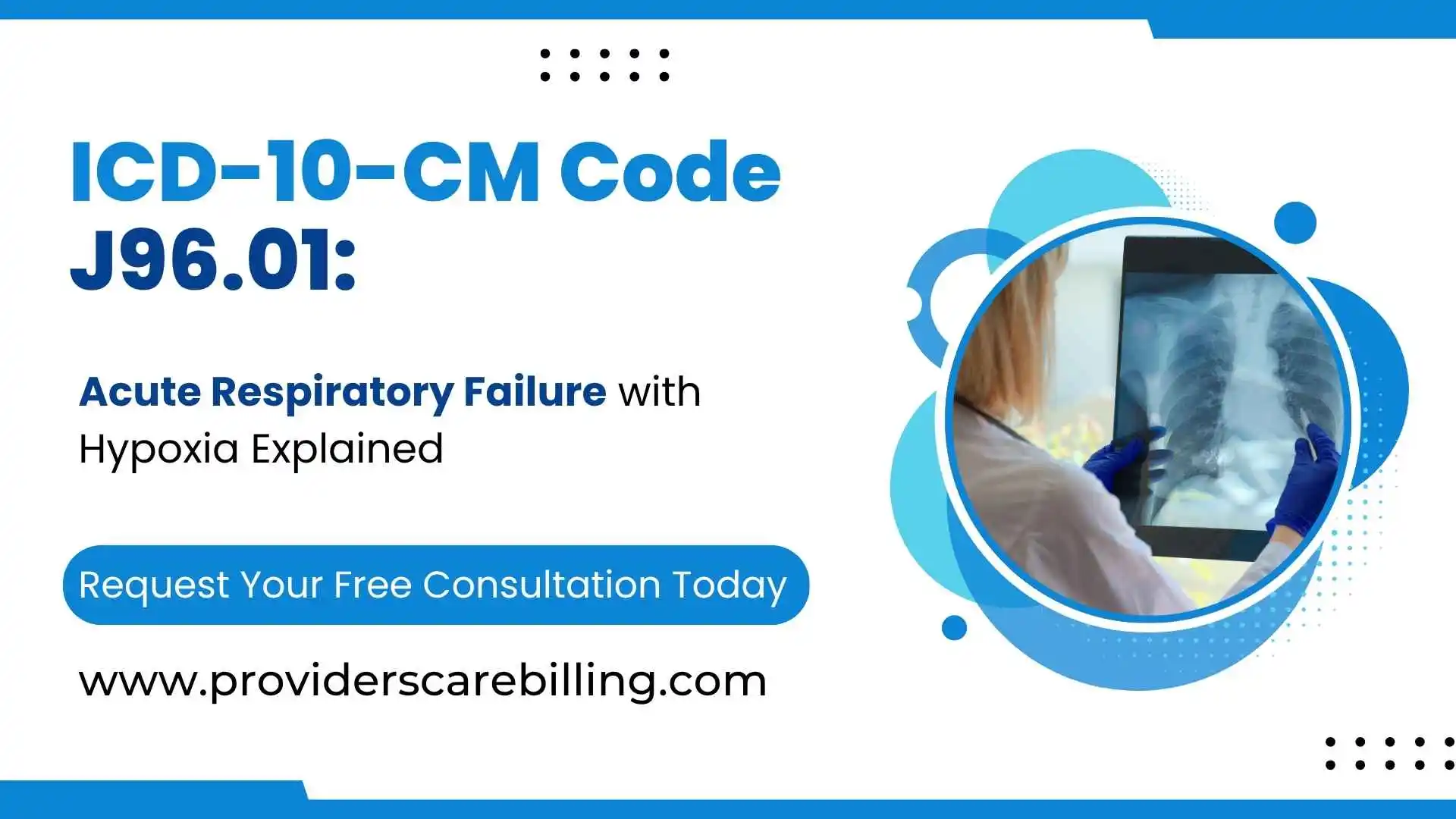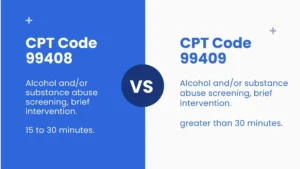Acute respiratory failure with hypoxia ICD 10 is important not only to search engines but also to the fiscal well-being of your practice, especially when considering the history for ICD-10 code. The knowledge of J96.01 guarantees accurate clinical representation and best reimbursement, particularly for unspecified whether with hypoxia. With more than 15 years of corporate experience in Medical Billing, Providers Care Billing LLC is assisting clinics and hospitals in making the best use of this accuracy to perform their revenue cycles.
Did you know that proper coding of the acute respiratory failure with hypoxia (J96.01) may raise the reimbursement level by 20-30 percent, as the codes of respiratory failure may be referred to as unspecified?
Acute Respiratory Failure (ARF)
The syndrome is described as respiratory failure that happens when either or both functions of the respiratory system to exchange gases fail, that is, oxygenation and carbon dioxide elimination, which can be coded with the appropriate ICD-10-CM code. This happens when the small blood vessels (also called capillaries) cannot fix the carbon dioxide and oxygen the way they ought to, in which case, the person is diagnosed with hypoxemia. Respiratory failure may be either chronic or acute.
Acute respiratory failure (ARF) is normally managed as a medical emergency, and it happens when there is accumulation of fluid in the air sacs within your lungs and which prevents flow of oxygen to the blood in the lungs. Looking at this condition, unless it is treated promptly, the condition may, in most cases, be fatal. The acute respiratory failure has severe complications that can be reversed with proper and adequate care on time.
Signs and Symptoms
In the majority of situations, respiratory insufficiency will be present in patients with ARF. The signs and symptoms of this condition have common grounds and generally depend on the causes of the condition and the amount of oxygen and carbon dioxide in your blood. Some include :
- Rapid breathing
- Air hunger (feeling like you can’t get as much air as you need) is a common symptom of hypoxemia that can lead to acute respiratory failure if not addressed.
- Sleepiness
- Restlessness, confusion, and anxiety can be symptoms of hypoxia-coding conditions.
- Rapid and shallow breathing can indicate a need for ICD-10 code documentation.
- A racing heart may occur in patients experiencing hypoxia-induced conditions.
- Rapid sweating is another condition that may be related to hypoxia-induced conditions.
- Loss of consciousness
- Irregular heartbeats (arrhythmias)
- Bluish facial flush around the skin, fingertips, or lips
- Inability to breathe
ARF Diagnosis and Documentation
Acute respiratory failure is a condition that needs urgent medical attention and appropriate ICD-10-CM coding to ensure proper treatment and reimbursement. Consequently, patients need to be given oxygen, which enables them to breathe normally and avoid death of tissues within the brain and other body organs, especially in cases of hypoxemia. When the state of the patient is being stabilized, doctors can start the process of completely diagnosing the condition.
Physicians can perform a comprehensive physical examination and analyze your past medical condition as an aspect of preliminary diagnosis, especially when considering whether with hypoxia or hypercapnia. They are also able to check your carbon dioxide and oxygen in your body by using pulse oximeters and arterial blood gas tests. Additionally, a chest x-ray will also be carried out to check for abnormalities in the lungs.
What are ICD-10 Codes of Acute hypoxic respiratory failure?
Acute hypoxic respiratory failure is among the most common and severe conditions in the field of medicine that often necessitate an ICD-10-CM code in order to diagnose the patient properly.
- J96.01 – Hypoxemic respiratory failure is a life-threatening situation that should be addressed promptly and, more importantly, be coded correctly, including the ICD-10-CM code of acute respiratory failure. Patients with low oxygen saturation in the blood and people in need of quick medical assistance are the target demographic of this code.
- J96.20 – Acute and chronic respiratory failure, unspecified, with or without hypoxia and or hypercapnia. This code will be used in cases where there is a lack of indication on the record whether the respiratory failure is acute or chronic, hypoxic or hypercapnic.
- J96.21 – Hypoxia respiratory, acute, chronic failure. The code is applicable in cases where acute and chronic respiratory failure is experienced, and the patient experiences hypoxia.
In some cases, acute respiratory conditions like hypoxia may coincide with findings such as a solitary pulmonary nodule, which requires further imaging and diagnostic workup.
J96.01 vs. Alternatives; when to use
- J96.02 – Use this when hypercapnic failure (PaCO 2 > 50 mmHg, pH < 7.35).
- J96.21 – Use this when chronic failure is covered by acute hypoxia.
- J80 – Use ARDS (PaO 2 /FiO 2 = 300 + bilateral infiltrates).
- J96.00 – Use when neither hypo-/hypercapnia is reported.
Which filling Acute Hypoxic Respiratory Failure ICD Codes are Billable?
Now, let us look at the question of billability of the above-provided Acute Hypoxic Respiratory Failure ICD codes.
- J96.01 – Indeed, it can be a billed code, which means that it is an acceptable diagnosis being submitted as a claim, such as the ICD-10-CM code for acute respiratory failure.
- J96.20 – Of course, it is also a billable code and can be applied to submit a claim.
- J96.21 – Yes, this code is billable, and it indicates an acceptable diagnosis when making claims.
Stuck with your respiratory failure codes?
Claim your free documentation audit with Providers Care Billing LLC and detect unallowed J96.01 activities right now.
📞 Call Now: 888-495-3786
📧 Email: Info@providerscarebilling.com
Why does it matter?
1. Improved Reimbursement :
Acute J96.01 usually pays more than the non-acute J96.00.
2. Audit Defense Regulatory Compliance :
Specific coding minimizes the risk of denial because it is aligned with CMS and payers’ requirements, including the use of the 2025 ICD-10-CM diagnosis code.
3. Clinical Accuracy :
Facilitates accurate and pertinent documentation.
4. RVU Integrity :
Ensures that the measure of productivity is a good reflection of the work done by clinicians.
Conclusion
The blog describes acute respiratory failure on hypoxia (ICD‑10 J96.01), including clinical indications (PaO 2 <60 mmHg, SpO 2 <90 percent, respiratory distress), documentation requirements, and contrast to J96.00, J96.02, and J96.21 and ARDS (J80). It focuses on coding best practices, appropriate linkages to underlying factors, and pointers on reducing denials.
FAQS
Q: What are the medical conditions where J96.21 is to be used in place of J96.01?
J96.21 is used when chronic respiratory failure (e.g., COPD) is superimposed with acute hypoxia (demonstrated by both baseline and acute decrease in PaO2 by at least 10 mmHg)




